Coins have a long, rich, and lucrative history. Coin enthusiasts, or numismatists, often invest in coins because of their artistic or historical value. In some instances, coin collecting also offers promises of long-term financial benefits.
While rare and ancient coins typically generate the most interest from people, newer coins are also appealing to collectors. In recent years, we have seen an increase in collectibles, and coins have been no exception. With this in mind, let’s take a look at the 1976 Bicentennial Quarter.
1976 Quarter Details
- Type: Washington Quarters
- Quantity Produced: 1,691,961,954
- Designer: John Flanagan (obverse), Jack L. Ahr (reverse)
- Edge: Reeded
- Shape: Round
- Coin Diameter: 24.3 mm
- Coin Thickness: 1.75 mm
- Coin Weight: 5.67g
- Year of Minting: 1976
- Mint Mark: None/D/S
- Place of Minting: Philadelphia, San Francisco, and Denver
- Face Value: $0.25
- $ Price: $0.25 – $7,000
The 1976 Bicentennial Quarter is also known as the Washington Quarter. The coin was made to celebrate the 200th anniversary of the signing of the ‘Declaration of Independence’ in 1776. The quarter was minted in 1975 and 1976.
The production of the coin commenced in 1975 to prevent people from hoarding them as they were intended to be regularly seen by the public. During the production process, nearly two billion of these coins were produced. The 1976 Quarter forms part of the many circulating commemorative coins from the 1970s due to its patriotic theme.
The coin features a special reserve design and the dates ‘1776 – 1976’ to commemorate the event. The special reverse image was designed by Jack L. Ahr in 1973 during an open contest hosted by the Treasury.
The design of the coin was surrounded by controversy. Jack was accused of plagiarizing the design from a 1973 stamp. However, it was later suggested that both the coin and the stamp drew inspiration from Archibald Willard’s 1876 painting ‘Spirit of ’76’. Later, the design was modified by Frank Gasparro, the Mint’s Chief Engraver. He simplified the design and added authenticity.
The reverse image was designed with the culmination of the American Revolution in mind. In the image, a colonial drummer is a focal point. A torch encircled by thirteen stars is featured to the left of the soldier, above the inscription “E PLURIBUS UNUM.”
The ‘United States of America’ and the denomination ‘Quarter Dollar’ are aligned to the coin’s circumference in a clockwise and anticlockwise direction, respectively. The inscription is a Latin phrase that means “One from many,” which is in reference to the formation of America from multiple independent states.
The obverse design contains a left-facing portrait of George Washington which was inspired by the Jean-Antoine Houdon bust. The infamous dual date ‘1776-1976’ is featured at the bottom of the coin, and the American motto, ‘In God we trust,’ occupies the space to the left of the bust.
There are two types of Bicentennial Quarters, and they are differentiated based on their metal composition. The 1976 clad Washington quarter consists of 91.67% copper with a pure copper core and an outer layer of 75% copper and 25% nickel.
In contrast, the silver Washington Quarter is a silver-clad coin comprising 40% silver and 60% copper. The core contains 20.9% silver, while the coat of the coin contains 80% silver. Both varieties have a thickness of 1.75 mm, a diameter of 24.3 mm, and reeded edges.
The silver variety weighs 5.75 grams which are slightly heavier than the copper variety’s weight of 5.67 grams. The weight difference is attributed to the 2.3 grams of silver in the silver-clad coin.
Also Read: Top 15 Most Valuable Quarters In Circulation
1976 Quarter Value Chart
| Coin | Extremely Fine | MS63 | MS65 | MS67 |
| 1776-1976 No Mint Mark Clad Bicentennial Quarter | $0.25 | $0.50 | $1 | $60 |
| 1776-1976 D Clad Bicentennial Quarter | $0.25 | $0.50 | $1 | $90 |
| 1776-1976 S Silver-Clad Bicentennial Quarter | $1.41 | $1.41 | $1.56 | $12 |
1976 Quarter Value and Varieties Guides
Let’s take a look at the different varieties of the 1976 quarter.
1776-1976 No Mint Mark Clad Bicentennial Quarter
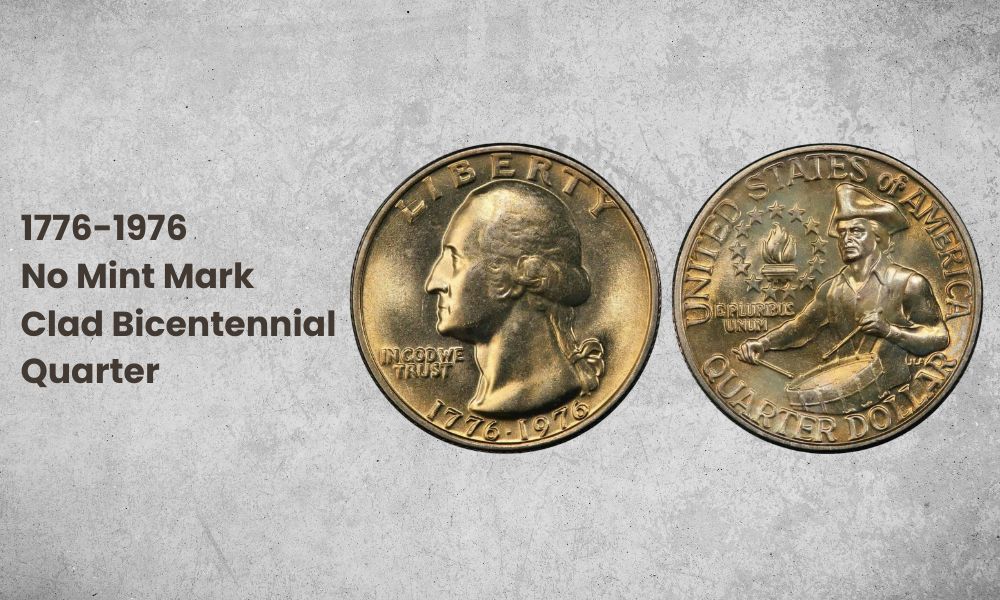
- Type: Washington Quarters
- Edge: Reeded
- Mint Mark: None
- Place of Minting: Philadelphia
- Year of Minting: 1976
- Face Value: $0.25
- $ Price: $0.25 to $60
- Quantity Produced: 809 million
- Designer: John Flanagan (obverse), Jack L. Ahr (reverse)
The Philadelphia mint struck over 809 million clad quarters (i.e., the copper variety) which were easily differentiated due to their lack of a mint mark. These coins were extensively circulated and, therefore, only fetch a face value of $0.25.
1776-1976 D Clad Bicentennial Quarter
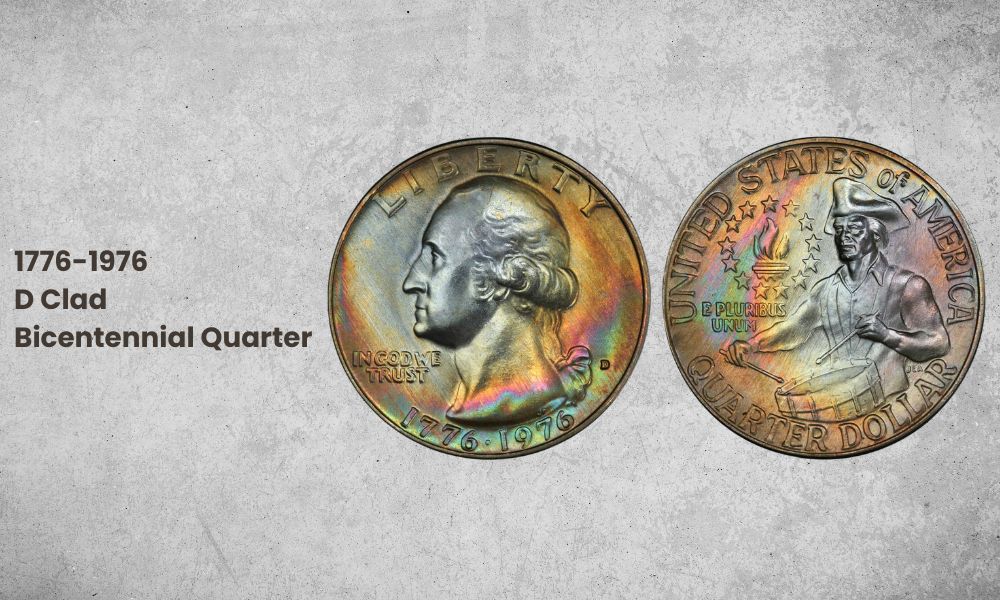
- Type: Washington Quarters
- Edge: Reeded
- Mint Mark: ‘D’
- Place of Minting: Denver
- Year of Minting: 1976
- Face Value: $0.25
- $ Price: $0.25 to $90
- Quantity Produced: 860 million
- Designer: John Flanagan (obverse), Jack L. Ahr (reverse)
This variant was produced by the Denver mint, and over 860 million clad quarters were struck. The coins can be differentiated by the ‘D’ inscribed on the obverse side of the coin, to the left of Washington’s bust. Circulated coins of this variety, in average condition, fetch their face value. However, pieces in a mint state may fetch slightly more than $6.
1776-1976 S Silver-Clad Bicentennial Quarter
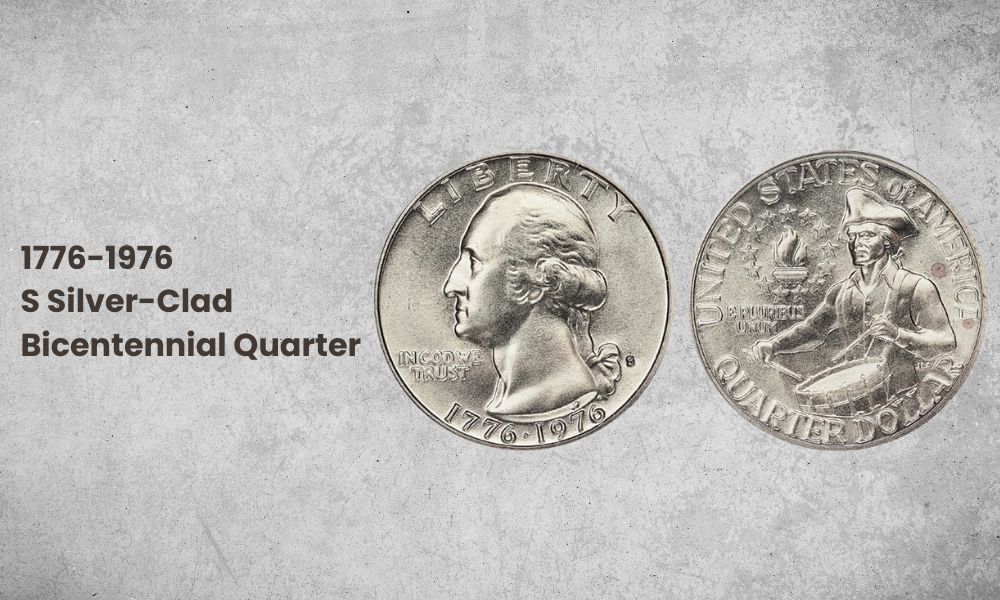
- Type: Washington Quarters
- Edge: Reeded
- Mint Mark: ‘S’
- Place of Minting: San Francisco
- Year of Minting: 1976
- Face Value: $0.25
- $ Price: $0.25 to $12
- Quantity Produced: 11 million
- Designer: John Flanagan (obverse), Jack L. Ahr (reverse)
The San Francisco mint produced 11 million silver-clad quarters in 2023. These coins have the letter ‘S’ inscribed on the obverse side and can therefore be easily distinguished from the coins produced in the other mints. These coins are relatively inexpensive and can be obtained for a face value of $3.40, depending on the condition.
1776-1976 S Proof Clad Bicentennial Quarter
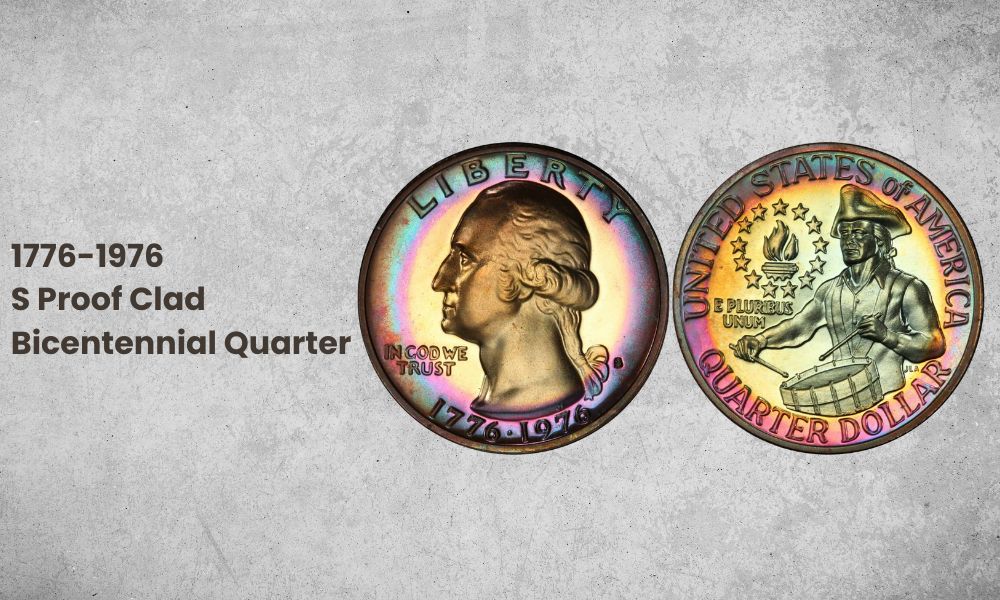
- Type: Washington Quarters
- Edge: Reeded
- Mint Mark: ‘S’
- Place of Minting: San Francisco
- Year of Minting: 1976
- Face Value: $0.25
- $ Price: $4 to $85
- Quantity Produced: 7 million
- Designer: John Flanagan (obverse), Jack L. Ahr (reverse)
This variant was also produced by the San Francisco mint. Over 7 million proof quarters were produced. Proof coinages are the highest quality commemorative coins or early samples of a coin.
Proof coins are distinguished from normal coins due to their mirror-like surfaces. These coins are struck twice to achieve this finish. Despite this, the coins are not very valuable and typically retail between $0.25 and $5.5. However, they can fetch higher prices at auctions.
1776-1976 S Proof Silver-Clad Bicentennial Quarter
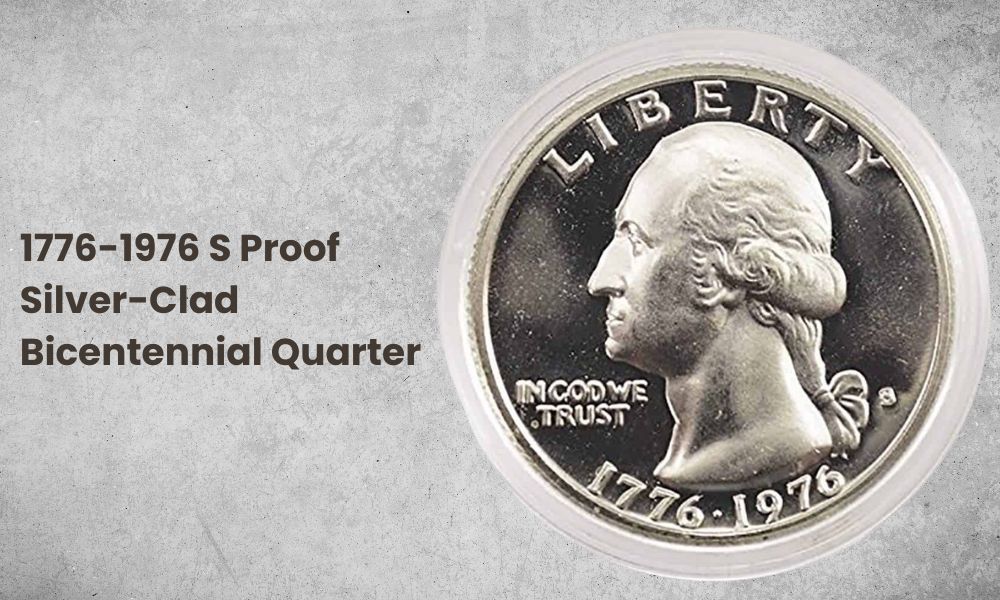
- Type: Washington Quarters
- Edge: Reeded
- Mint Mark: ‘S’
- Place of Minting: San Francisco
- Year of Minting: 1976
- Face Value: $0.25
- $ Price: $8 to $180
- Quantity Produced: 4 million
- Designer: John Flanagan (obverse), Jack L. Ahr (reverse)
This is the final variant produced by the San Francisco mint. This quarter comprises 40% silver, and 4 million of them were produced. These coins can typically be obtained for approximately $8 to $12, but similar to the S-proof clad quarter, they can fetch higher sums at auctions.
Also Read: Top 16 Most Valuable Modern Quarters Worth Money
1976 Quarter History
The Bicentennial coins were produced alongside half-dollar and dollar coins. This was prompted by the celebration of the nation’s bicentennial. New designs for the coins and the production of a commemorative coin were suggested by ‘The American Revolution Bicentennial Commission Coins and Medals Advisory Panel.’
However, their suggestion was rejected by the Treasury Department. Their rejection was based on the premise that commemorative coins are not an ideal medium of exchange. These coins are typically hoarded, used to generate profit, and are not readily accessible or recognizable to the public. Thereby diminishing the purpose of the coinage system.
Coin collectors were persistent and wanted redesigned coinage in addition to a gold issue. The Treasury eventually relented and agreed to add the dates ‘1776 – 1976’ to the coins. However, they remained adamant that no design changes would be made to mark the Bicentennial.
A compromise was eventually struck between coin collectors and The Treasury through the prompting of coin enthusiasts in Congress. The change was officially authorized in the Act of October 18, 1973.
Due to the coins being made in honor of the Bicentennial anniversary, many people were hopeful that they would be worth a fortune in the future. They were sadly mistaken as the coin production was so extensive that some coins are still in circulation today.
In fact, this was likely due to the mixed reviews from coin enthusiasts. The designs were not well-received, and the Mint was stuck with a surplus of these coins that they were unable to sell. The Mint’s plan to prevent hoarding inevitably backfired, with many people disappointed that they do not possess an invaluable rarity.
Coins that are currently in circulation are often only worth their ‘face’ value. While there are plenty of coins in circulation, high-quality coins are difficult to find.
Also Read: 10+ Rarest State Quarter Errors Lists (Worth Much Money!!!)
1976 Quarter Grading
The grading system is used to determine the condition of the coin and consequently its value. The Sheldon Coin Grading Scale is used by American numismatics and coin enthusiasts to assess the quality of their coins.
It is a 70-point grading scale, with higher scores reflecting better coin quality. The scores are grouped into various ‘grades’ that serve as a qualitative description of the coin. Typically, you would want to steer from ‘basal state’ grades and aim for ‘mint state’ grades.
1976 quarters in the mint state have fetched huge sums at auctions. For example, a silver quarter with an MS 69 grade was sold for $19,200. However, less impressively, a no-mint copper-clad quarter was sold for $1,200, and a Denver-clad quarter with an MS 68 grade was sold for $6,463. These auctions are unpredictable thus making this particular set of coinage a risky investment.
List of 1976 Quarter Errors
1. Like most things in life, the minting process is not perfect. Due to the extensive production process, there are numerous specimens with errors in them. In the coin community, however, there is beauty in the imperfections and these coins are often more expensive than mint-condition coins.
1. Doubled Die
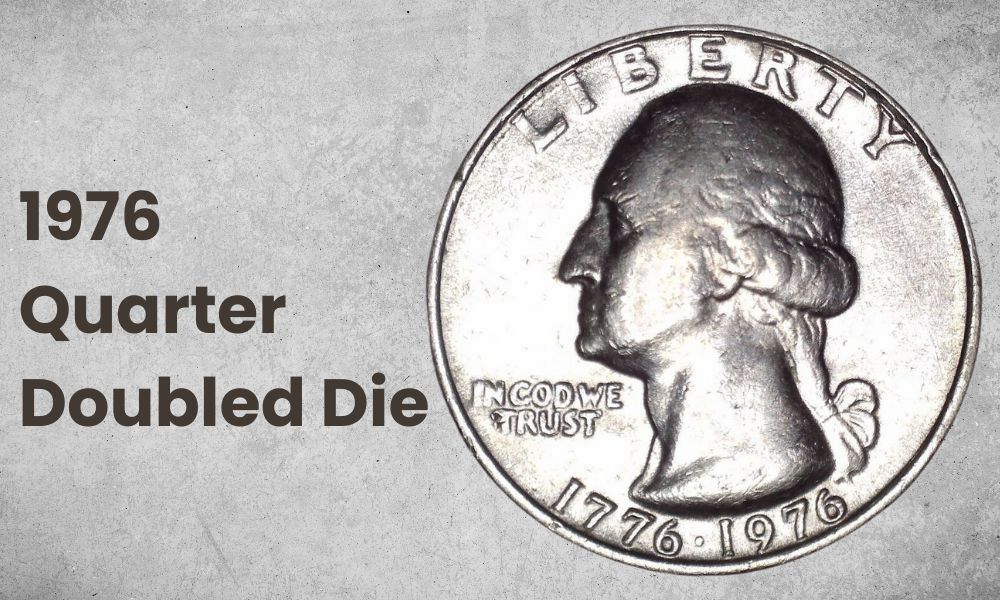
A double die happens when the coins are struck on a defective die. This resulted in double inscriptions on both sides of the coin. These ‘Doubled Die’ errors are worth anything between $800 and $3,500.
2. Overstruck quarters
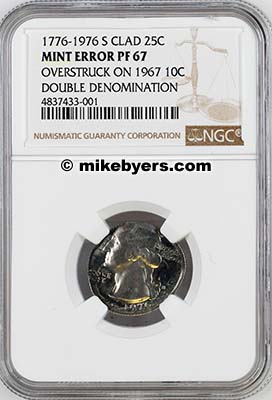
This happens when coins are pressed again, or the coin is pressed onto the wrong planchet (e.g., nickel struck on a cent). The design for the dime was sometimes seen in the Washington Quarter, thus making it a rare find. The coins can go for over $10,000.
3. Struck through the quarter
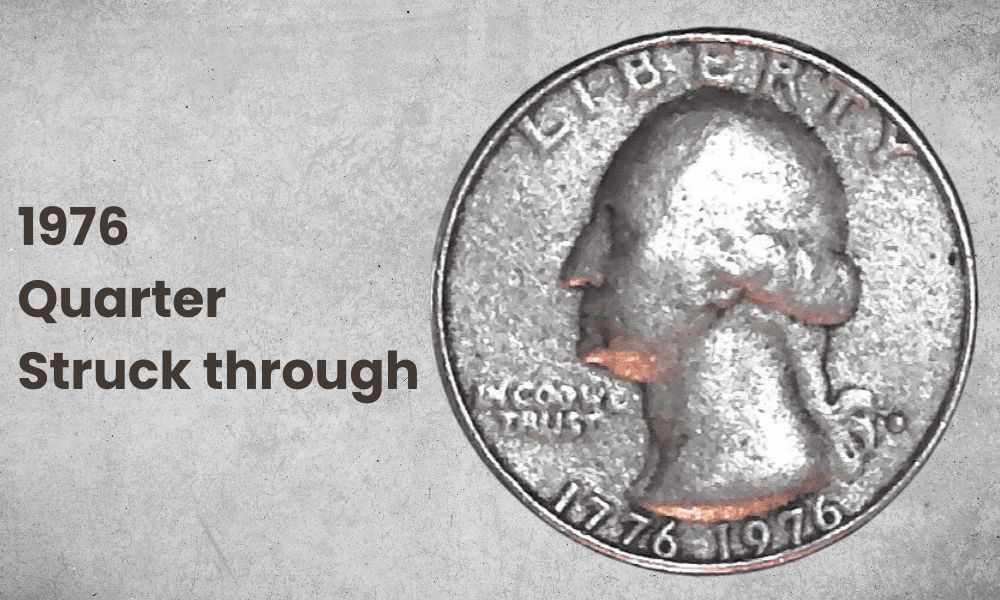
Fabric is sometimes present during the mint process, and the pattern of the fabric gets imprinted over the design. These errors are typically found on the obverse side of the Washington Quarters and are incredibly rare. A struck-through quarter with an MS 66 grade was potentially sold for $900.
4. Colonial drummer
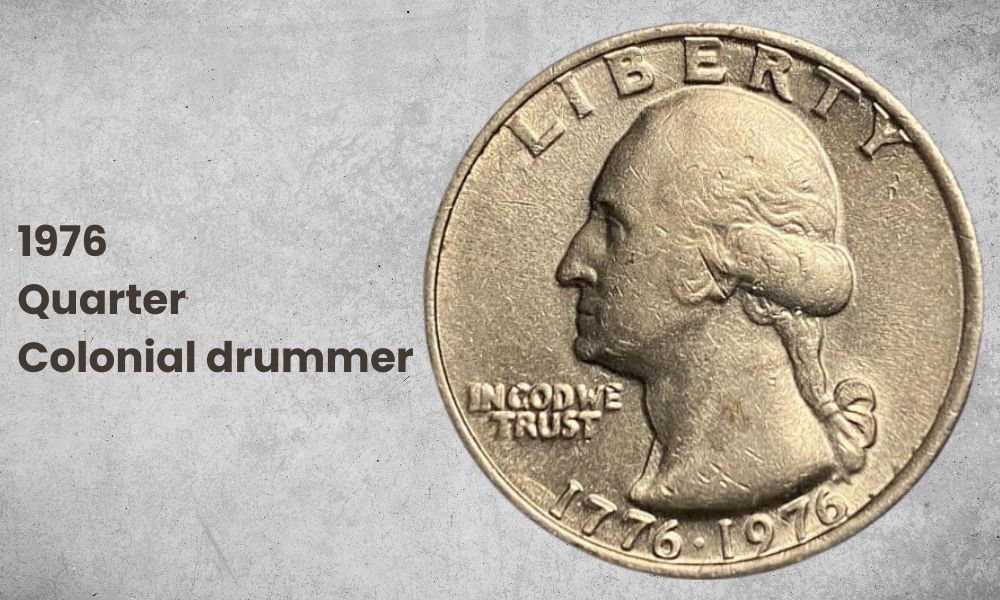
This error needs an experienced eye to identify it. The image of the drummer is slightly blurry. This is most likely due to the die being dirty, with excess grease. The difference is minimal, and a casual observer wouldn’t notice the difference.
5. Off-center on the obverse side
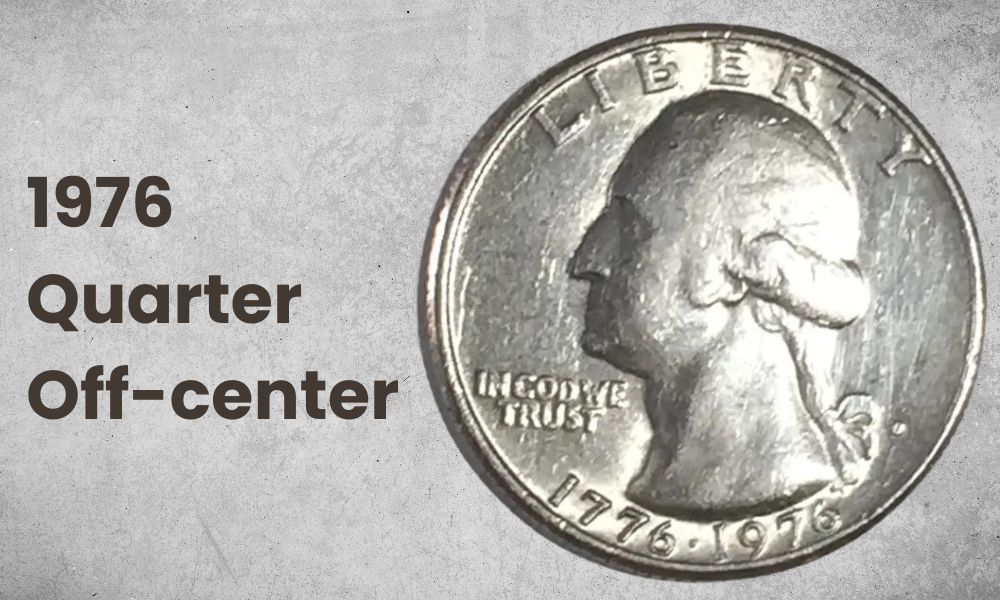
This error occurs when the planchet is incorrectly mounted during the minting process. The coin is therefore struck incorrectly and features anywhere from 5 to 95% of the design. The most valuable specimens are the ones that feature a small percentage of the original design.
Interestingly, the 1976-D Washington Quarters are rarely fully struck. The drum’s top rim and clasp are often not visible. It is incredibly difficult to find a specimen with a full drum. However, despite their rarity, there is no real demand for this variety.
1976 Quarter Value FAQs
1. What is the rarest variety from this set of coinage?
Well, all the coins that feature errors are quite rare and fetch more money than regular coins. The San Francisco mint also produced a range of silver-clad quarters for President Gerald Ford. These coins do not have the traditional ‘S’ mint mark.
These coins were never in circulation, so we do not know if they still exist. The last record of this coin was at the American Numismatic Association Convention when it was gifted to the President’s secretary.
Interestingly, it has been reported that all first strikes were melted and are not even available in the National Numismatic Collection. These incredibly rare coins would therefore be extremely expensive if they were ever presented on the market.
2. Why is the 1976 quarter not worth more?
These coins have been in circulation for 47 years and have therefore not become rare. Coins that are in circulation for a long time are readily available and, not worth more than their ‘face’ value. Especially when they were made in huge quantities.
3. Are bicentennial quarters worth keeping?
Unfortunately, unless they are error specimens or in pristine condition, they will not provide any financial benefits. However, if you are attempting to build a coin collection, then you should certainly hold onto these quarters,
4. What quarters are worth money?
Any quarters with errors or rare varieties. However, the 1974 and 1977 quarters that were struck on 40% silver-clad planchets are incredibly unique and expensive. One of these coins can cost up to $1,000.
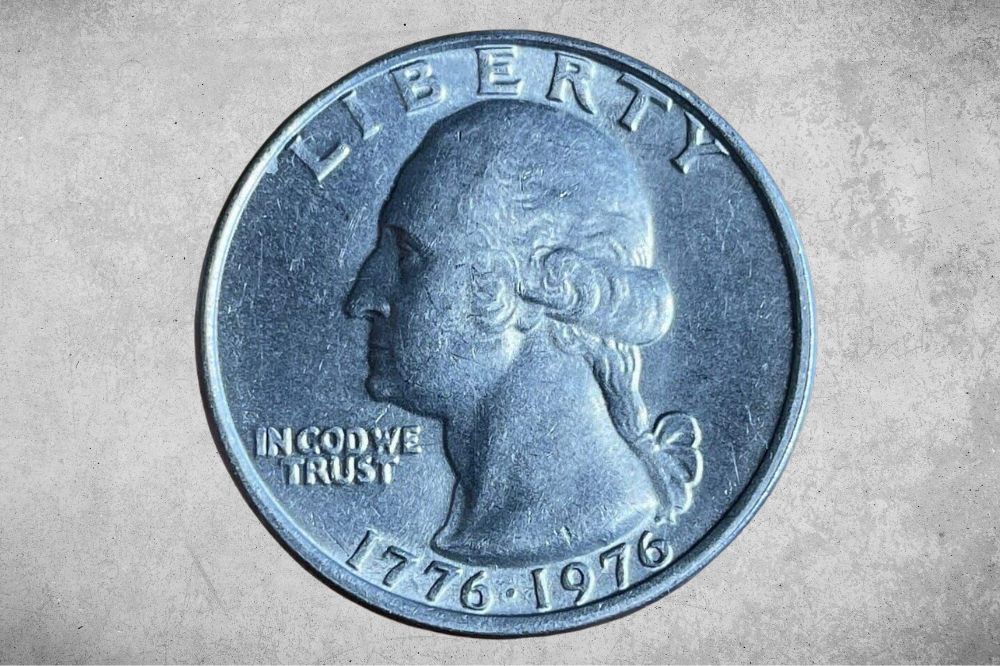
ive got a 1776-1976 quarter dollar no mint mark.